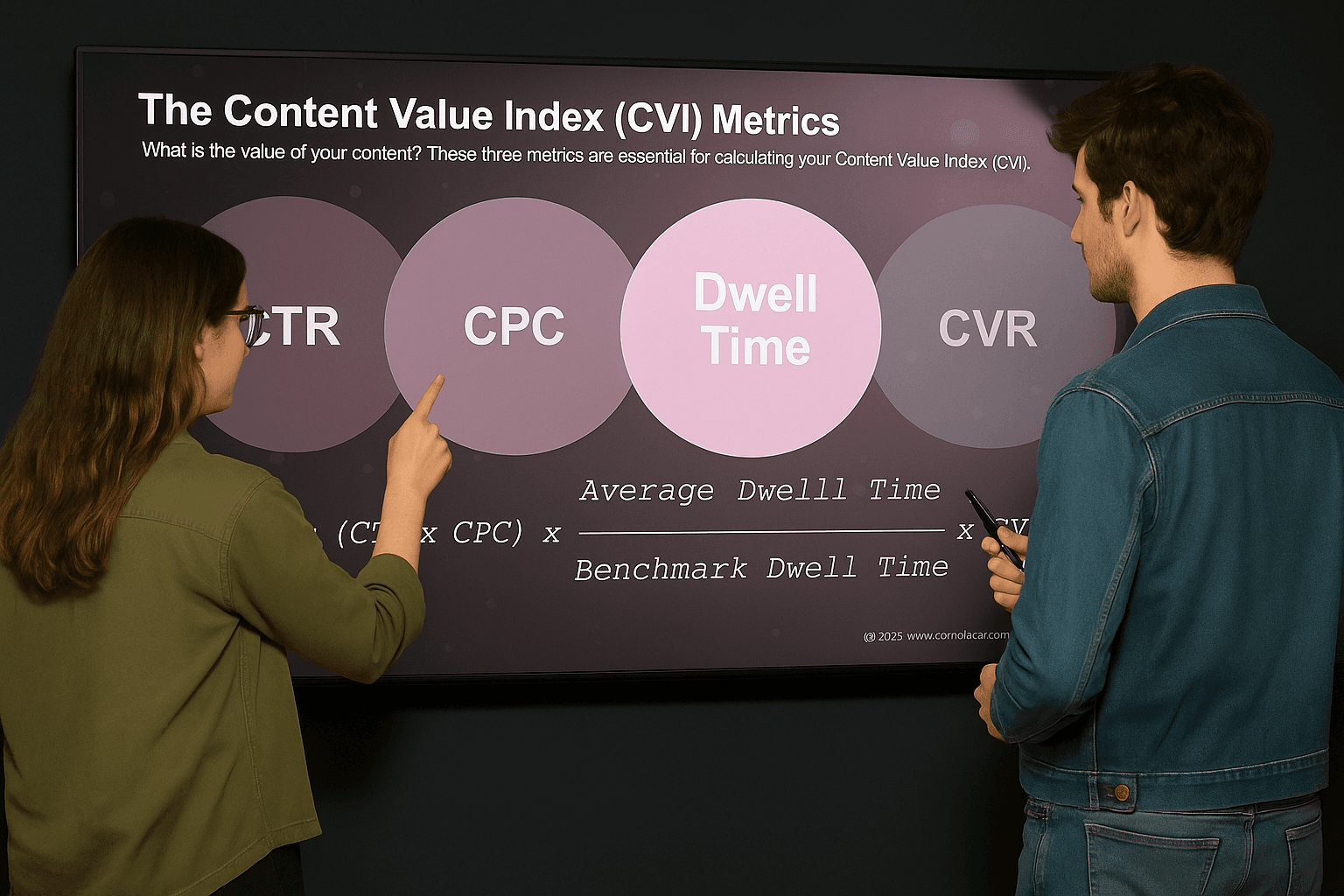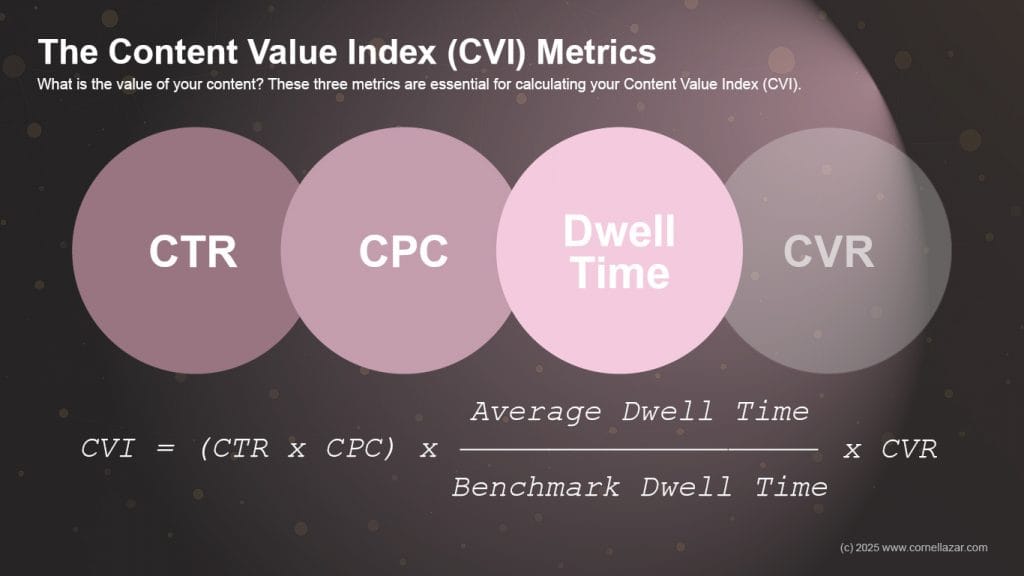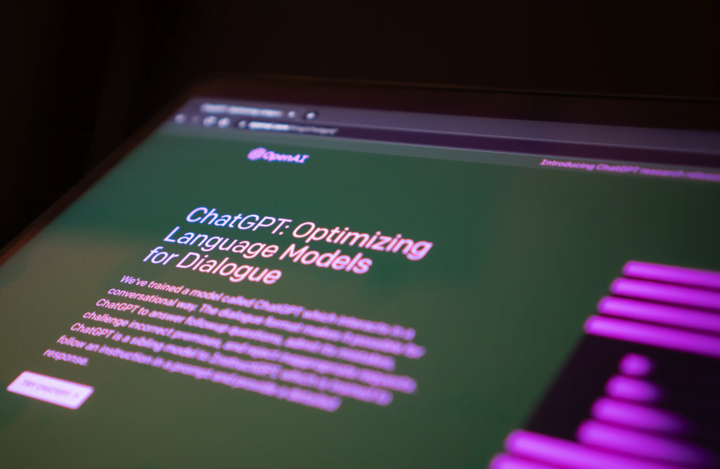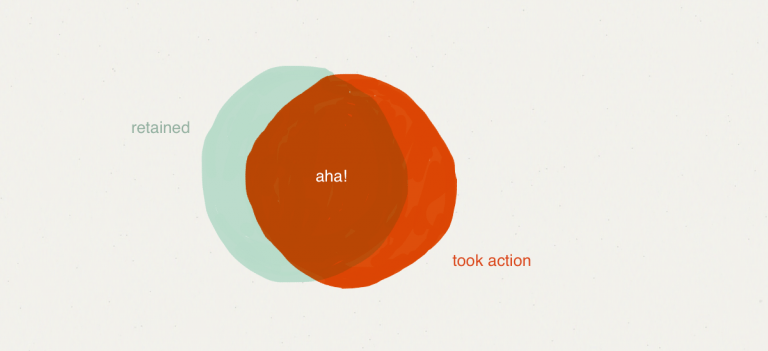Measuring the impact of our content has always been one of marketing’s biggest challenges. We’re expected to prove that content drives business value, yet too often we rely on vanity metrics that tell only part of the story. Page views, likes, or impressions might look good in a report, but they don’t show whether our content actually moves the needle.
I’ve compiled this guide to help us go beyond surface-level metrics and show how to connect content performance to real business outcomes. As marketers, when we understand what to measure and how to interpret it, we can turn content from a cost centre into a measurable growth driver.
In a hurry? Here’s your …
TL;DR
- Most marketers still rely on vanity metrics for organic content that don’t prove real value.
- I share a practical framework to measure content marketing ROI using real metrics: CTR, CPC, Dwell Time, and CVR.
- The Content Value Index (CVI) translates engagement into measurable business value.
- When we connect creativity with data, content stops being a cost and becomes a strategic growth driver.
- Focus on quality, distribution, and ROI – not just volume.
The Challenge: Proving Content Marketing ROI
Let’s start with where many of us are today. Most teams are under pressure to justify investment in content, but we’re often stuck tracking metrics that don’t demonstrate value.
Common pitfalls include:
- Measuring output instead of outcomes (counting blogs, not results)
- Focusing on traffic volume, not visitor quality
- Ignoring engagement depth, such as how long users stay on a page
- Treating SEO and paid metrics as separate rather than connected
The result is that marketing reports look busy but lack a clear line to ROI. We can tell what’s popular, but not what’s profitable.
The Vision: When Content Becomes a Growth Engine
Now imagine the opposite. Every piece of content you publish has a clear role in your funnel and measurable business impact. You know exactly which formats attract high-quality visitors, which pages nurture interest, and which drive conversion.
That’s what a unified measurement framework delivers. When we align content metrics with business value, we can confidently answer the questions every leader asks: What’s working? What’s not? And what’s the ROI?
When you can prove ROI, content becomes strategy, not spend.
Cornel Lazar
This shift turns content from a marketing activity into a growth lever. It also earns us more trust, budget, and influence across the organisation.
The Solution: Measuring What Really Matters
To get there, we need to move beyond disconnected metrics and adopt a measurement model that ties engagement, cost, and outcomes together. Below is a practical framework I use that combines SEO, paid media logic, and behavioural metrics into one formula.
| Metric | What It Represents | Why It Matters |
|---|---|---|
| CTR (Click-Through Rate) | Percentage of people who click after seeing a link | Measures relevance and appeal of your message |
| CPC (Cost-Per-Click) | Monetary value of one click in paid media | Helps assign a comparable value to organic traffic |
| Dwell Time | How long users stay on a page before returning to search | Indicates engagement quality and content value |
| CVR (Conversion Rate) | Percentage of visitors who take a desired action | Links engagement to tangible business outcomes |
| Repeat Visitor Ratio (RVR) | Share of visitors who return after their first visit | Reflects brand trust and ongoing audience interest |
Each metric tells part of the story. When combined, they reveal both acquisition efficiency and engagement depth.
2. The Content Value Index (CVI)
The CVI translates engagement metrics into monetary value. It asks a simple question:
“What would this organic traffic have cost us if we had to buy it?”
Then it adjusts that media value based on how engaging the content is.
Base Formula:
CVI = CTR × CPC × (Avg Dwell Time / Benchmark Dwell Time)
Where:
- CTR is click-through rate (decimal format)
- CPC is cost-per-click for the target keyword
- Avg Dwell Time is the average time on page
- Benchmark Dwell Time is your baseline for “good engagement”
If your dwell time is higher than the benchmark, your content performs above average for its acquisition cost. If it’s lower, it’s underperforming.
| Metric | Example Value |
|---|---|
| CTR | 0.08 (8%) |
| CPC | £2.50 |
| Avg Dwell Time | 180 seconds |
| Benchmark Dwell Time | 120 seconds |
CVI = 0.08 × £2.50 × (180 / 120)
CVI = £0.30 per impression
That means every search impression effectively generates £0.30 worth of engagement-weighted value. Multiply that by total impressions to estimate total organic media value.
3. CVI Adjusted for Conversion (CVIₐ)
To make this model even more actionable, we can factor in the Conversion Rate (CVR).
Adjusted Formula:
CVIₐ = CTR × CPC × (Avg Dwell Time / Benchmark Dwell Time) × CVR
This version connects engagement and conversion, showing the full-funnel value of content.
Example (with CVR)
| Metric | Example Value |
|---|---|
| CTR | 0.08 |
| CPC | £2.50 |
| Avg Dwell Time | 180 sec |
| Benchmark | 120 sec |
| CVR | 0.04 (4%) |
CVIₐ = 0.08 × £2.50 × (180 / 120) × 0.04
CVIₐ = £0.012 per impression
By aggregating this across impressions, you can assign a financial value to each piece of content based on both visibility and conversion.
4. Distribution: Owned, Earned, and Paid Media
No matter how good your measurement model is, content without distribution doesn’t perform. I always come back to the Content Distribution Trifecta, which is the mix of owned, earned, and paid media.
- Owned Media:
Your website, blog, and social channels. These are assets you control. Use SEO and PPC to drive traffic to them. - Earned Media:
Mentions, shares, and reviews from others. This is credibility you earn through value and relevance. - Paid Media:
Advertising, paid promotions, and influencer partnerships. Use this to amplify reach and accelerate engagement.
When all three work together, you maximise visibility and strengthen your performance data. Owned content gives you control, earned media builds trust, and paid campaigns provide scale.
5. Creating Content That Delivers Value
Once measurement and distribution are in place, we must ensure our content itself is worth measuring. I use a simple five-part checklist before publishing anything.
Findable:
- Include H1 tags and metadata
- Add internal links and image alt tags
Readable:
- Use short paragraphs, bullet points, and headers
- Follow an inverted pyramid style (most important info first)
Understandable:
- Write for your personas’ knowledge level
- Choose the right format (text, video, infographic)
Actionable:
- Include clear calls to action
- Link to related or next-step content
Shareable:
- Give people a reason to share it
- Make sharing easy with widgets or hashtags
If your content passes this checklist, you’re already ahead of most teams.
We don’t need more content. We need content that proves its worth.
Cornel Lazar
6. Measurement Model: Step by Step
Here’s how to bring it all together into a repeatable process.
- Step 1: Gather Data
From Google Analytics, Search Console, and ad platforms, collect CTR, CPC, Dwell Time, and CVR. - Step 2: Calculate CVI or CVIₐ
Apply the formulas for each key piece of content. - Step 3: Benchmark and Compare
Group content by type or funnel stage and see which performs best. - Step 4: Estimate Media Value
Multiply your CVI by total impressions to assign a media value to organic content. - Step 5: Analyse and Improve
Use insights to adjust titles, structure, and CTAs based on which metrics lag behind.
As an additional layer:
Connect your content’s CVI trend with keyword performance. When Dwell Time and CTR increase together, it’s often a sign your SEO strategy is perfectly aligned with audience intent.
Case Example: Applying the Model
Let’s say a landing page has:
- CTR: 8%
- CPC: £2.50
- Dwell Time: 3 minutes
- Benchmark Dwell Time: 2 minutes
- CVR: 4%
Using the CVI formula:
CVI = 0.08 × £2.50 × (180 / 120) = £0.30
Adjusted for conversion (CVIₐ):
CVIₐ = 0.08 × £2.50 × (180 / 120) × 0.04 = £0.012
If the page received 20,000 impressions, its engagement-weighted organic media value would be £6,000.
That’s a strong way to show leadership the real worth of organic performance and justify content investment with data.
Key Takeaways
- Track what matters. Focus on CTR, Dwell Time, CPC, and CVR to connect content with ROI.
- Benchmark performance. Compare engagement against realistic baselines to identify what’s under or overperforming.
- Quantify value. Use the CVI formula to turn engagement data into monetary value.
- Distribute smartly. Combine owned, earned, and paid channels for maximum impact.
- Iterate constantly. Measure, refine, and repeat to build a culture of continuous optimisation.
Build a Culture of ROI-Driven Content
Content marketing ROI isn’t just a KPI. It’s proof that what we do matters.
When we measure the right things, every article, video, or campaign becomes part of a bigger story about how marketing drives business growth.
As fellow marketers, we owe it to ourselves and our teams to work smarter, not noisier. Audit your content metrics this week. Test the CVI model on one or two pages. You might be surprised how much value you’re already creating and how much more you can prove.
I’ve learned that the more clearly we can connect creativity with performance, the stronger our voice becomes inside the business. That’s what turns content marketing from an activity into a strategy and why mastering ROI measurement is one of the most valuable skills any of us can develop today.
The more clearly we connect creativity with performance, the stronger our voice becomes inside the business.
Cornel Lazar















